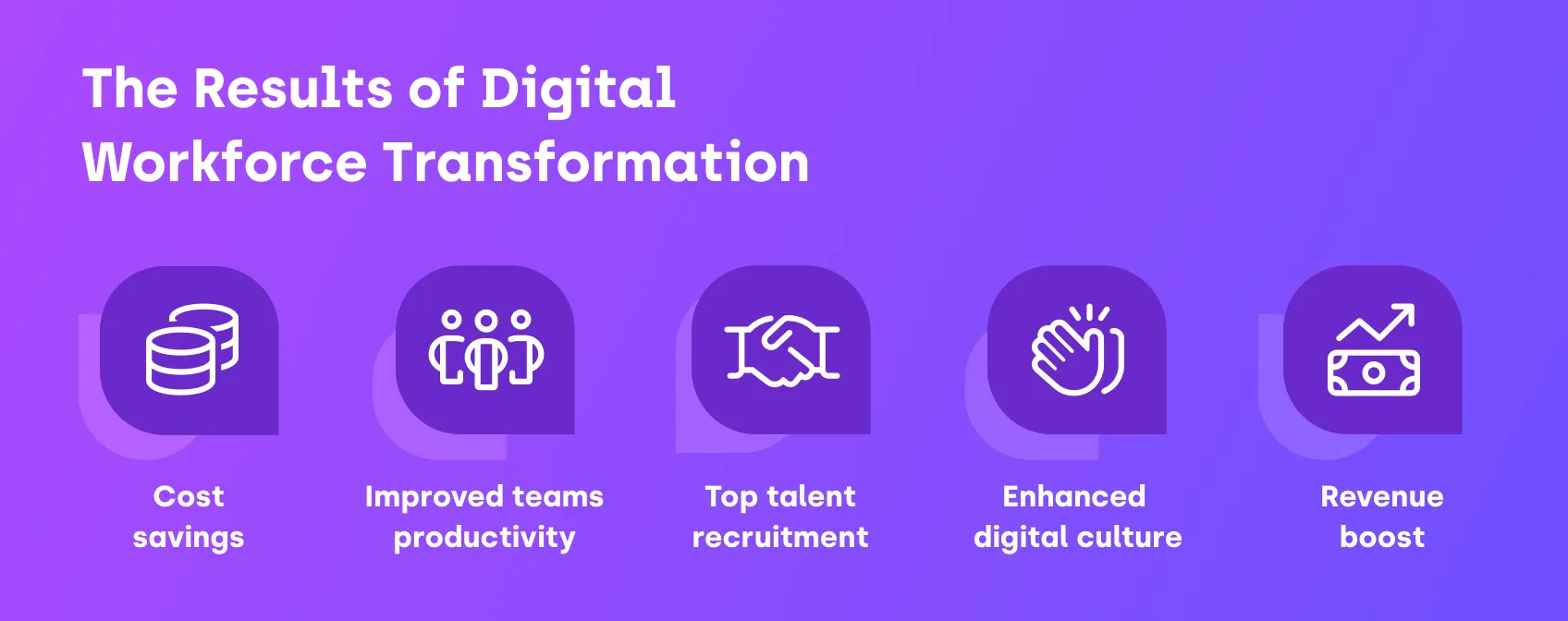
Digital workplace transformation: The basics

The digital workplace has been around for some years, driven by the rapid advancement of digital technologies that reshape our work. Remote work that became the norm during the pandemic allowed for the blossoming of the digital workplace worldwide.
But have we managed to adapt our organizations and make the best of what the digital mode of work truly offers in terms of productivity and flexibility? While there is significant progress in many respects, digital workplace transformation is still a process that most companies need to engage in to maximize the benefits of the new work modes.
Let’s go over the basics of the digital workplace and how we can transform it to bring out the best in it.
What is a digital workplace?
A digital workplace is the virtual version of the traditional office. Employees are connected through technology but don’t necessarily need to work together in the same place. More often than not, they’re at opposite ends of the planet. They are connected through digital devices, software, and hardware.
The digital workplace thus allows for unseen levels of productivity and agility for companies while providing flexibility and employee benefits. It can directly contribute to higher revenue and rapid innovation across departments if optimized properly.
While the digital workplace is a progressive mode of operation and speeds up several positive processes in how we work today, it also comes with some risks that companies need to bear in mind. By applying digital transformation in a smart way, your organization can optimize remote work and digital collaboration and achieve its business goals with a dispersed team.
How to improve a digital workplace?
Reimagining the digital workplace starts with putting employees first — and building up the digital collaboration processes in a way that leads to improving productivity and agility, increasing customer satisfaction, and boosting business results.
The path to achieving these improvements passes through the digital transformation of existing structures and business processes. However, this should not simply be done todigitize documents and digitalize organizational processes. Instead, digital transformation focuses on completely overhauling an organization’s operations.
Thus, improving your work entails full innovation, and most importantly, it needs a significant cultural change in the company. Adapting to a dispersed and digitally-based way of working is, first and foremost, a task for the team.
All digital processes, tools, and strategies need to revolve around the needs of employees and should be synchronized with your long-term business goals.
How to prepare a workplace for digital transformation?
Preparation is critical to success — this certainly applies to the workplace’s digital transformation.
It’s important to assess your organization’s current state, including its digital maturity and existing business operations and processes. It may be worth including an employee survey at this step to check out where your team is at.
Next, you need to imagine the desired endpoint of the transformation process. Defining your digital transformation goals paves the way to employing a sound digital transformation strategy that will make your revamped digital workforce fuel your business success.
Afterward, it’s time to research and identify the most fitting technology to enable your employees to make the most of your digital workplace initiatives. Digital tools should be helpers, and not obstacles, to higher productivity and should make people’s lives easier.
The results of digital workforce transformation

Digital workforce transformation, if executed properly, can impact your organization’s bottom line directly.
Some of the direct digital transformation benefits that can be observed include the following:
- Cost savings — from downsizing and optimizing offices
- Improved productivity of teams — measured through completed tasks and projects
- The hiring of top talent — the best employees can be recruited for globally dispersed teams, as they can be based anywhere
- Improved employee experience and digital culture — people get a higher level of flexibility and user-friendly tools
- Boost revenue through improved overall productivity and agility
The top digital technologies for the workplace
While there is a wide variety of tools, a few essential types are absolutely necessary for a fully functioning workplace.
Collaboration and communication
For dispersed teams, a powerful communication and collaboration software platform are especially important — since team members can’t bump into each other in the office kitchen. It should provide your workforce with an easy way to exchange work-related information and engage with each other informally.
Data and document management
An unimaginable amount of documents is created daily in each team. This means that people need to have an efficient and easily accessible way to create, collaborate, and share documents and other types of data across dispersed working locations.
Project and task management
Employees need a powerful tool to schedule, coordinate amongst themselves, and manage tasks and projects. That’s why a project and task management tool is a priority. Automating routine tasks and processes is also important, as it can save your staff time and resources. That’s why choosing a platform that allows for workflow, and even robotic process automation is a good idea.
Cybersecurity
With the number and efficiency of cyber attacks increasing, having a sound cybersecurity system in place is critical. It should protect your data and workforce from malicious attacks and infiltration.
Your digital workplace strategy: 3 hacks for improving productivity and agility
A digital transformation roadmap is highly recommended before you start with digital workforce transformation. Here are our top tips based on experience with many organizations that have gone through the change with us.
#1. Create a vision with clear business goals
Setting up a strategy starts with a big vision that would unite your business to go through the transformation in unison. This means you need to get on board key members of all departments who will help run the process smoothly, united by a common and well-understood plan.
Besides that, ensure that your vision aligns with your overarching business goals — you want to move in the right direction on all levels.
#2. Think about your employees first
Digital workforce transformation is essential for optimizing your organization’s performance today. And it all starts with putting your employees first — as they are the people who, together with you, can make your business flourish through digital innovation.
It’s useful to set up employee personas to clearly differentiate the different needs and processes of the different types of employees. Some common characteristics you can attribute to the personas are mobile use, content creation, content consumption, technology adoption level, and know-how of organizational practices.
Once you’ve set your transformation process in motion, you must provide training for your workforce. Often the best approach is to set up a continuous learning system, which may require hiring training personnel too. It’s also good to collaborate with ‘change management leaders’ in different departments who will help make the transition smoother from the inside — and will help boost employee productivity.
#3. Choose the right technology
Digital workplace transformation entails a detailed review of all current technology, practices, and workflows. Once you’ve gone over those aspects and identified trends and obstacles, it’s time to set up new pathways and select the right tools for your team to boost employee engagement.
It’s imperative that all digital platforms you employ function together and provide contextual synchronization and real-time data delivery. Thus, choosing the right technology is one of the critical challenges of digital transformation.
Cloud- and mobile-first technologies are certainly to be preferred. Data storage should be easy-to-use and readily accessible across devices. It’s also a good idea to embed an intuitive and user-friendly communication platform that enables instant messaging, file sharing, and real-time and effective collaboration.
Why you should launch a digital workplace transformation now?
There has never been a better time to get started with your workplace’s digital transformation.
All the conditions are there: the internet is everywhere, there are powerful digital devices, software tools are becoming better than ever, and progressive employees are keen to embrace what the new technologies have to offer for remote collaboration.
The Covid-19 pandemic profoundly affected the level of adoption of the digital workplace. While many business leaders were previously skeptical about remote work, being forced to introduce it during the pandemic allowed them to test the advantages and disadvantages first-hand. Many of them were persuaded, so today, many companies operate in hybrid mode, combining operating office space and remote work or in a completely dispersed mode.
In addition, more and more employees opt for remote work. This means that organizations must adapt to boost employee satisfaction — if they want to keep their best staff.
So now, since we’re all on the same page about the positives of the dispersed workplace that employs digital tools, it’s a matter of mastering how to apply it in your organization. This is where skillful digital workplace transformation comes in.
Master your digital workplace transformation with Resolute Software
With rich experience behind our backs, our experts at Resolute Software have helped numerous companies successfully undertake their digital workplace transformation journey.
Keen to learn how Resolute Software can contribute to your organization’s digital transformation process? Get in touch today.
FAQs
The term refers to the remote online collaboration of teams using technology to communicate and exchange data and deliver business results.
Improvement can be achieved by using the latest and most appropriate technology to drive flexibility, adaptability, and productivity of teams across the globe.
The term denotes transforming the modern dispersed remote office by employing the latest digital technology combined with the smartest methods.
This strategy is a set of methods to maximize work with a dispersed team using digital technology to communicate, exchange data, and collaborate.





